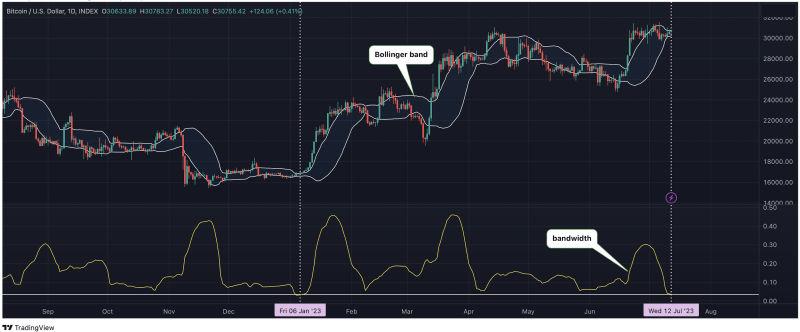
A technical analysis indicator called Bollinger Bands, signaling a volatility explosion in bitcoin (BTC), has grabbed the attention of crypto traders and analysts ahead of the U.S. inflation report for June.
“Bollinger bands are tight. How tight? Squeezes of this caliber have only ever occurred a handful of times in the past decade. Most squeezes like this have tipped the market bias before the breakout,” analyst early Wednesday, adding that a similar tightening of bands was last seen in early January, just before bitcoin’s bull revival.
The so-called squeeze or tightening of bitcoin’s Bollinger bands has also caught the eye of , the inventor of the indicator.
Bollinger bands are derived by placing volatility lines two standard deviations above and below the 20-day simple moving average (SMA) of the asset price. The bands are driven by the degree of price turbulence, with the squeeze or tightening of the bands representing volatility contraction and the widening of bands representing volatility explosion.
When bands tighten sharply, traders prepare for a big move and usually trade in the direction in which prices breach the band. The logic is that the market builds energy during consolidation, which is eventually unleashed in either direction.
The most common method of tracking the bandwidth is to divide the spread between the upper and lower bands with the 20-day SMA of prices.
Bitcoin’s Bollinger bandwidth has declined to 0.04, the lowest since early January, according to the charting platform TradingView.
As per pseudonymous analyst the bandwidth has been this low only a handful of times in bitcoin’s 14-year history, and we might see a volatility explosion soon.

Tighter bands do not always imply immediate and notable volatility explosion/directional clarity in the market.
That said, the U.S. CPI data, scheduled for release on Wednesday at 12:30 UTC, will likely influence the Federal Reserve interest rate expectations and inject volatility into markets.
Per economists polled by Wall Street Journal, the headline year-on-year CPI is likely to have cooled to 3.1% in June from May’s 4.0%, with the core figure slowing to 5% from 5.3%.
A reading of 3.1% would bring the headline closer to the Fed’s target of 2%, weakening the case of continued interest rate hikes or monetary tightening that was partly responsible for last year’s crypto crash. In other words, bitcoin may break out of the Bollinger band squeeze if the inflation data matches estimates.
Note that expectations for a big drop in CPI have been amped up by a report released Tuesday that showed used car prices, one of the key components of the U.S. CPI, tanked by 10.3% over the past year, recording the 10th straight monthly decline in June.
So, risk assets, including bitcoin, may see downside volatility if the headline CPI and the core figure come in hotter-than-expected. Bitcoin traded dead flat near $30,630 at press time, per CoinDesk data.
Edited by Parikshit Mishra.

